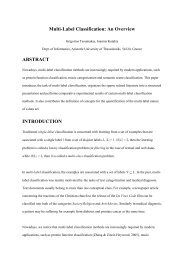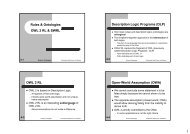You also want an ePaper? Increase the reach of your titles
YUMPU automatically turns print PDFs into web optimized ePapers that Google loves.
2. Frames and Inheritance 16<br />
<strong>flex</strong> toolkit<br />
frame animal .<br />
frame carnivore .<br />
frame mammal is an animal<br />
default blood is warm and<br />
default habitat is land .<br />
frame rodent is a kind of mammal<br />
default habitat is sewer .<br />
frame feline is a mammal, carnivore .<br />
There are three kinds of isa links used in this example hierarchy.<br />
A single connection between the parent-frame and the child-frame, i.e. one-to-one.<br />
An example of this is the link between animal and mammal, and is the usual<br />
kind of link to be found in hierarchies.<br />
Links from a parent-frame to more than one child-frame, i.e. multiple children.<br />
An example of this is the link between mammal and its two sub-classes, rodent<br />
and feline. In this case both rodent and feline are types of mammal, and<br />
share some characteristics (like warm blood), but not necessarily all<br />
characteristics.<br />
Links from a child-frame to more than one parent-frame, i.e. multiple parents. An<br />
example of this is the linkage from mammal and carnivore to the class<br />
feline. In this case a feline has some of the characteristics of a mammal<br />
and some of the characteristics of a carnivore. Here, the ordering of the<br />
parenthood is important, as it affects the order for which inherited values are<br />
returned by the inheritance search algorithm. This capability to have more than<br />
one parent is sometimes referred to as multiple inheritance.<br />
By inheritance from mammals, all felines and all rodents are warm-blooded.<br />
However, whilst all felines live on land, the locally declared default for a<br />
rodent's habitat will override the inherited default from mammals, with the<br />
result that rodents are deemed to live in sewers. If we now defined, say, a<br />
squirrel as a kind of rodent, then the default value for their habitat attribute<br />
would be a sewer.<br />
Creating an Instance of a Frame<br />
So far we have discussed the use of frames to represent general (static)<br />
objects such as mammals, felines and rodents. However, frames may also<br />
represent specific (dynamic) instances of objects such as Sylvester (a wellknown<br />
cat) or Sammy (my cat).<br />
In formal terms there is very little to distinguish a frame representing a class<br />
of objects from an instance representing a specific instance of the frame.<br />
Instances appear as leaf nodes in the frame hierarchy and can have only one








